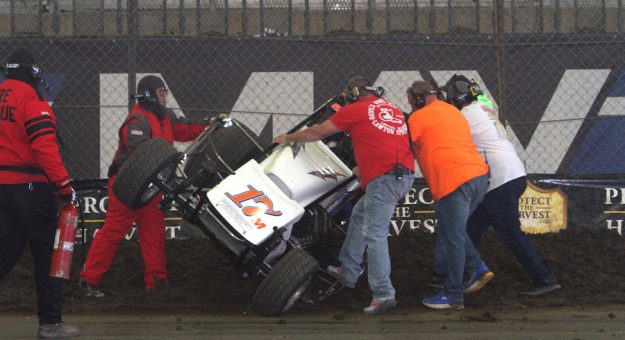Few people have a more complete understanding of the complexities of producing a race of the magnitude of the Chili Bowl Nationals than Steve Sinclair.
He has led the Interstate Racing Ass’n for more than three decades and for many years was in the race control booth at Tulsa Expo Raceway.
At the Chili Bowl, Sinclair handled RACEceiver operations, the critical system that allows one-way communication with the participants. It is a key function in presenting a crisp program. He also views the event from an additional vantage point. Since 2010, he has served as a Field Underwriter for K&K Insurance.
When he thinks about all that happens over the course of a single night at the Chili Bowl, Sinclair observes, “There is a lot going on up there. It is a lot for one person to do. When I worked with Matt Ward or Tommie Estes, who were the race directors, if I saw something I tapped them on the shoulder. It is also different because the lights are controlled up top. Here you also don’t go red unless it is really bad.”
The sparse use of the red flag catches the attention of many. Fans and teams grow accustomed to a very different scenario all summer long. In most cases if a driver turns over, an immediate red flag is signaled. Not at the Chili Bowl.
Sinclair grew to be comfortable with the procedures used in Tulsa.
“I think one reason you can do that here is because the guys get out there really quick and the staff here is really good at relaying information,” Sinclair said. “If a driver needs a few minutes to gather themselves, you go red. If they said they were fine, and everything looked good, we tipped them back over and went on. I think they are trying to save time, and it creates more fumes with drivers starting and stopping and when trucks are rolling around. But again, I think the guys do a really good job.”
The importance of controlling fumes is a high priority at this race as is the desire to run the program as quickly as possible.
Simply put, this isn’t a normal event. It is an annual happening played out in front of a large crowd and significant viewing audience. Because high-profile drivers and teams are involved many movers and shakers in the industry pay close attention. Because of this those in race control have a lot on their plate.
“There is just a lot going on. Take for example television,” Sinclair said. “One year we were ready to go live and someone had a heart attack, and another year someone fell out of the bleachers. Matt Ward and Tommie Estes had to be involved with the total event. They were looking at more than just racing. We’re cutting cars through the infield and trying to keep people safe. You have the ramp to contend with. There are just so many things to pay attention to.”
Nowadays Sinclair comes as a fan but given his inside knowledge he still marvels at what he sees.
“For 18 years I came here and there wasn’t a rig in the building,” he said. “Now it is like, wow. Look at this. This whole thing is choreographed now, and it is really amazing how it comes together.”
